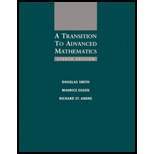
Concept explainers
a.
To find which of the following are algebraic structure also find out is the operation commutative or associative.
a.
Explanation of Solution
Given:
Calculation:
Consider the set of integers
Consider two elements from the given set.
The subtraction of two integers again gives an integer.
Therefore,
Hence
Associative part and commutative part:
It is known that the operation
b.
To find which of the following are algebraic structure also find out is the operation commutative or associative.
b.
Explanation of Solution
Given:
Calculation:
Consider the set of integers
Consider two elements from the given set.
The division of two integers like
Therefore,
Hence
Associative part and commutative part:
It is known that the operation
c.
To find which of the following are algebraic structure also find out is the operation commutative or associative.
c.
Explanation of Solution
Given:
Calculation:
Consider the set of real numbers
Consider two elements from the given set.
The subtraction of two real numbers again gives a real number.
Therefore,
Hence
Associative part and commutative part:
It is known that the operation
d.
To find which of the following are algebraic structure also find out is the operation commutative or associative.
d.
Explanation of Solution
Given:
Calculation:
Consider the set of real numbers
Consider two elements from the given set.
The division of two real numbers again gives a real number.
Therefore,
Hence
Associative part and commutative part:
It is known that the operation
e.
To find which of the following are algebraic structure also find out is the operation commutative or associative.
e.
Explanation of Solution
Given:
Calculation:
Consider the set of natural numbers
Consider two elements example
The subtraction of these two
Therefore,
Hence
Associative part and commutative part:
It is known that the operation
f.
To find which of the following are algebraic structure also find out is the operation commutative or associative.
f.
Explanation of Solution
Given:
Calculation:
Consider the set of rational numbers
Since
Therefore,
Hence
Associative part and commutative part:
It is known that the operation
g.
To find which of the following are algebraic structure also find out is the operation commutative or associative.
g.
Explanation of Solution
Given:
Calculation:
Consider the set of rational numbers
Since
Therefore,
Hence
Associative part and commutative part:
It is known that the operation
h.
To find which of the following are algebraic structure also find out is the operation commutative or associative.
h.
Explanation of Solution
Given:
Calculation:
As
Therefore,
Hence
i.
To find which of the following are algebraic structure also find out is the operation commutative or associative.
i.
Explanation of Solution
Given:
Calculation:
Consider the power set of any set
Consider two elements from the given set.
The intersection of two elements will give the elements that belongs to power set.
Therefore,
Hence
Associative part and commutative part:
It is known that the operation
j.
To find which of the following are algebraic structure also find out is the operation commutative or associative.
j.
Explanation of Solution
Given:
Calculation:
Consider the power set of any set
Consider two elements from the given set.
The subtraction of two same element will give
Therefore,
Hence
k.
To find which of the following are algebraic structure also find out is the operation commutative or associative.
k.
Explanation of Solution
Given:
Calculation:
Consider the set of
Since,
Therefore,
Hence
Associative part and commutative part:
It is known that the operation
l.
To find which of the following are algebraic structure also find out is the operation commutative or associative.
l.
Explanation of Solution
Given:
Calculation:
Consider the set of
Since,
Therefore,
Hence
Want to see more full solutions like this?
Chapter 6 Solutions
A Transition to Advanced Mathematics
 Algebra: Structure And Method, Book 1AlgebraISBN:9780395977224Author:Richard G. Brown, Mary P. Dolciani, Robert H. Sorgenfrey, William L. ColePublisher:McDougal Littell
Algebra: Structure And Method, Book 1AlgebraISBN:9780395977224Author:Richard G. Brown, Mary P. Dolciani, Robert H. Sorgenfrey, William L. ColePublisher:McDougal Littell Glencoe Algebra 1, Student Edition, 9780079039897...AlgebraISBN:9780079039897Author:CarterPublisher:McGraw Hill
Glencoe Algebra 1, Student Edition, 9780079039897...AlgebraISBN:9780079039897Author:CarterPublisher:McGraw Hill Elements Of Modern AlgebraAlgebraISBN:9781285463230Author:Gilbert, Linda, JimmiePublisher:Cengage Learning,
Elements Of Modern AlgebraAlgebraISBN:9781285463230Author:Gilbert, Linda, JimmiePublisher:Cengage Learning,


